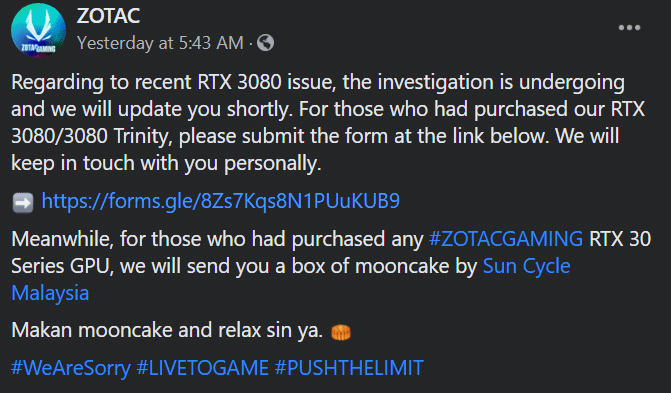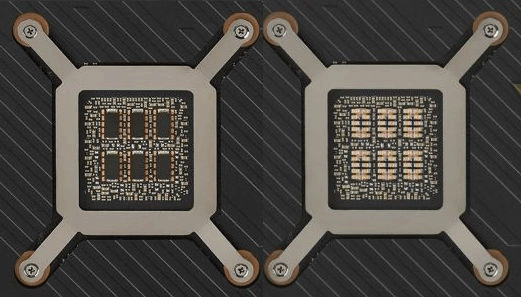Opposed to hastily posting semi-response of board partners on the CAP - MLCC issues we yesterday started collecting the responses that are of a more formal tone. First off, we reached out to the NVIDIA yesterday and aside from the driver update and one comment in their forums, it is just wicked to see that NVIDIA has not sent out a press-release on this topic.
There was one response in the NVIDIA, none to media. NVIDIA yesterday released driver revision GeForce 456.55 WHQL (download), in the descriptions "The new Game Ready Driver also improves stability in certain games on RTX 30 Series GPUs. What Nvidia did not mention its that it already holds a fix to help with the CTD issues:
Tim@NVIDIA - NVIDIA posted a driver this morning that improves stability. Regarding partner board designs, our partners regularly customize their designs and we work closely with them in the process. The appropriate number of POSCAP vs. MLCC groupings can vary depending on the design and is not necessarily indicative of quality.
So that means that NVIDIA is trying to fix the issue at driver level at this time. As I mentioned in the previous article. If the CTDs occur above 2 GHz, then that can easily be fixed with firmware and BIOS updates. The GPU is not supposed to boost in that frequency anyway.
First users are reporting that the new GeForce 456.55 GRD WHQL driver has fixed problems with instability in games. Many users speak of reduced maximum clock rates that only go slightly above 2.0 GHz, but no longer up to 2.1 GHz. With Nvidia’s new 456.55 drivers, the GPU clock speed in Horizon Zero Dawn now flitters between 1980MHz and 1995MHz (though it can still hit a stable 2010MHz in menu screens). Nvidia’s fix appears to be dialing back maximum performance with the GPU Boost feature.
Below an overview of board partner reactions and actions we observed. You should really check out the Inno3D one.
EVGA
EVGA was the first to comment on its own forum :
Hi all,
Recently there has been some discussion about the EVGA GeForce RTX 3080 series. During our mass production QC testing we discovered a full 6 POSCAPs solution cannot pass the real world applications testing. It took almost a week of R&D effort to find the cause and reduce the POSCAPs to 4 and add 20 MLCC caps prior to shipping production boards, this is why the EVGA GeForce RTX 3080 FTW3 series was delayed at launch. There were no 6 POSCAP production EVGA GeForce RTX 3080 FTW3 boards shipped.
But, due to the time crunch, some of the reviewers were sent a pre-production version with 6 POSCAP's, we are working with those reviewers directly to replace their boards with production versions.
EVGA GeForce RTX 3080 XC3 series with 5 POSCAPs + 10 MLCC solution is matched with the XC3 spec without issues.
Also note that we have updated the product pictures at EVGA.com to reflect the production components that shipped to gamers and enthusiasts since day 1 of product launch.
Once you receive the card you can compare for yourself, EVGA stands behind its products!
Galax
Galax posted the following:
Dear player friends:
Hello, everyone. Recently, many users have come to inquire about the specific usage of the capacitors on the back of the GALAXY RTX 3080/3090 series of graphics chips. After verification, about the RTX 3080/3090 released by GALAXY. The capacitors used on the back of the model chip are as follows:
1. GALAXY RTX 3080 Heijiang / Metal Master product, the number of SP-CAP capacitors on the back of the chip: 5, the number of MLCC capacitors: a set of 10. This version is currently on sale and is the original commercial version .
2. GALAXY RTX 3090 General / Metal Master product, the number of SP-CAP capacitors on the back of the chip: 4, the number of MLCC capacitors: two groups of 20. This version is currently on sale and is the original commercial version .
3. GALAX RTX 3090 GAMER trial production samples, currently only 6 pieces are in the hands of the media and KOL. The first batch of this sample uses 6 SP-CAP capacitors. After confirmation, the GAMER products officially produced and sold will be used for capacitor materials. Make optimization improvements. Note: This product is not currently on sale.
I am very grateful to the players and friends for their support and love to GALAXY. GALAXY is also consistent in its pursuit of product quality. It is our glorious mission to provide you with better and stronger hardware. In addition, the current full range of GALAXY graphics card products support three-year warranty and personal warranty service. If you have other doubts or questions, please feel free to leave us a message to discuss, thank you! - Galax (Weibo)
Gainward
Announcement on SP-CAP Capacitors and MLCC Capacitors of Gainsun 30 Series Graphics Card Products
Dear Gainward consumer players:
Thanks to the friends who bought and supported Gainward. Recently, we received the voice of market players' inquiries. Many players are very concerned about our company's just released 30 series products. Regarding the specific usage of the capacitors on the back of the chip, we hereby explain the situation:
All the RTX 3080 10GB graphics cards released by Gainward currently use 5 SP-CAP capacitors on the back of the chip and 10 MLCC capacitors. The versions currently on the market are all the original commercial versions. All the RTX 3090 graphics cards released by Gainward currently use 4 SP-CAP capacitors on the back of the chip and 20 MLCC capacitors. The versions currently on the market are all the original commercial versions. As a long-term AIC partner of Nvidia, Gainward has always been adhering to the product standard to design and produce completely according to Nvidia's requirements. Therefore, currently players are concerned about the problem of capacitors and new product failures on the Internet. Currently Gainward has not generated such feedback.
In addition, all Gainward graphics card products support three-year warranty and personal warranty service. Thank you consumers and players for your support and love to Gainward. - Gainward (Weibo) (via Videocardz).
Inno3D
The response from Inno3D is just absolutely offensive, I've warned about this company before. Personally, I would not be comfortable buying an Inno3D product ever again if this is how you deal with instability issues of products:
... just shocking to read.
ZOTAC
MSI
MSI updated the PCB component design on the TRIO with an extra cluster of 10 MLCCs, however, changed the photo back to the old one (one cluster of MLCCs), likely they deemed that their configuration already is sufficient for this card and not the issue of any CTDs. For the Ventus series, it looks like a revision is planned with one less SPCAP and added 10 MLCCs, to be on the safe side of things.
Gaming X Trio before - after
Ventus 3X before - after
As stated the image of the Trio has been swapped back, and that indicates that MSI likely is not convinced the configuration is the issue. We're currently awaiting feedback from MSI on this.
Colorful
Colorful fixes the issue for your GeForce RTX 3080 by lowering the frequencies using a BIOS update. Colorful decided to release a BIOS update for the RTX 3080, reducing its frequencies.
ASUS
ASUS would have revised the design of the ROG Strix RTX 3080 and the TUF RTX 3080 in early stages but a change was noticed. Photos indicate SPCAP configured cards to get full MLCC designs. To date, ASUS has not communicated about the CTD issues.
Gigabyte
In response to the recent reports speculating that the use of POSCAP capacitors on the GeForce RTX 3080 graphics cards could lead to stability issues and crashes, we would like to clarify the issue with the following statement:
It is false that POSCAP capacitors independently could cause a hardware crash. Whether a graphics card is stable or not requires a comprehensive evaluation of the overall circuit and power delivery design, not just the difference in capacitor types. POSCAPs and MLCCs have different characteristics and uses, thus it is not true to assert that one capacitor type is better than the other.
The GIGABYTE GeForce RTX 30 graphics cards are designed in accordance with NVIDIA specifications and have passed all required testing, thus the product quality is guaranteed. GIGABYTE GeForce RTX 3080 GAMING OC and EAGLE OC series graphics cards use high-quality, low-ESR 470uF SP-CAP capacitors, which meet the specifications set by NVIDIA and provide a total capacity of 2820u in terms of GPU core power, higher than the industry’s average. The cost of SP-CAP capacitors is not lower than that of MLCCs. GIGABYTE values product integrity highly and definitely does not reduce costs by using cheap materials.
NVIDIA has released a driver (version 456.55) on September 29, 2020 that improves stability. Users are advised to update to the latest driver for optimized performance. For users who have any concern, please contact our local service centers or representatives.
GIGABYTE has been constantly improving and optimizing product quality, especially in terms of thermal designs, to provide the best gaming experience to the consumers for decades. For the latest AORUS GeForce RTX 30 graphics card series, we have also paid extra attention to the cooling performance and introduced industry-leading solutions such as MAX-Covered Cooling to ensure that the operation of each component is stable.
| Model | NVIDIA RTX 3080 Reference Design | GIGABYTE RTX 3080 GAMING OC & EAGLE OC |
| GPU core Power | SP-CAP 220u/9m OHM *5 MLCC 22u *10 | SP-CAP 470u/6m OHM *6 |
| Total Capacity(u) | 1320u | 2820u |
Manufacturers on RTX 3080 CTD issues, Inno3D Offers a Shocking Response






